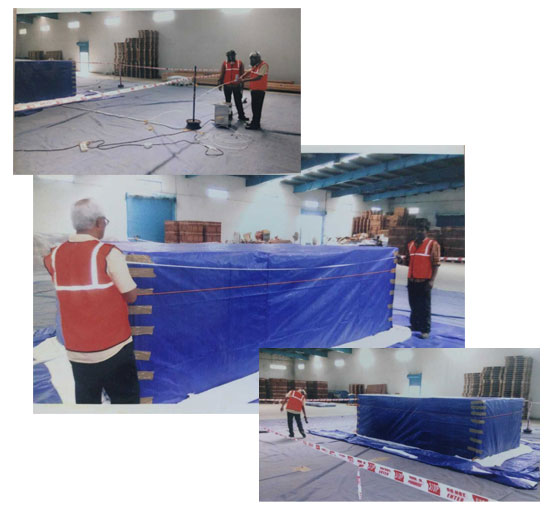Pallet cover Fumigation
Pallet cover fumigation refers to the process of fumigating goods that are stacked on pallets and wrapped or covered with a special material, often plastic or similar impermeable sheets, to create a sealed environment for the fumigation process. This method is commonly used in the transportation and storage of goods to ensure that they are free from pests, fungi, and other contaminants without the need to fumigate individual items separately.
Purpose of Pallet Cover Fumigation:
-
Pest Control: It is primarily used to control infestations of pests such as insects, termites, or rodents that may be present in wooden or cardboard pallets or within the goods being transported.
- Prevention of Contamination: It helps protect items from fungal growth, mold, or other biological contaminants that could affect the quality or safety of the goods.
- Efficient Process: Instead of fumigating each individual item, pallet cover fumigation allows for large volumes of goods to be fumigated at once, making it a more cost-effective and time-efficient method.
Materials Used for Pallet Cover Fumigation:
- Plastic or Polyethylene Sheets: These are commonly used to cover the pallet and the goods to form a sealed environment.
The cover is air-tight to prevent the fumigant from escaping, ensuring that the chemicals used in the fumigation process are confined and effective.
- Fumigant: The choice of fumigant depends on the type of pests or contaminants being targeted. Common fumigants include:
Methyl Bromide – A highly effective fumigant used to control pests and fungi.
Phosphine (e.g., aluminum phosphide) – A popular fumigant for controlling insect pests.
Sulfuryl Fluoride – Used for fumigating goods like dried foods and some other products sensitive to other chemicals.
Steps Involved in Pallet Cover Fumigation
Preparation of Pallet and Goods:
Goods are carefully stacked on pallets to ensure even fumigation. The stacks should not be too tightly packed, as this can prevent proper gas circulation.
The goods on the pallet may include anything from food items to electronic products, textiles, or timber, depending on the nature of the shipment.
Covering the Pallet:
A plastic or polyethylene sheet is then placed over the pallet, covering the entire stack of goods. This cover should be large enough to wrap around the pallet and seal it tightly.
The cover should be secured, ensuring there are no gaps or openings through which the fumigant can escape. The edges of the plastic are typically sealed with tape or ties to form an airtight seal.
Introduction of Fumigant:
Fumigation typically begins by releasing the fumigant into the sealed area under the plastic cover.
The fumigant is introduced in a controlled manner, either as a gas or in tablet form (e.g., phosphine), which releases gas over time.
Depending on the fumigant used, the fumigation process can take anywhere from a few hours to several days.
Monitoring the Process:
During fumigation, the concentration of the fumigant is monitored to ensure it reaches the appropriate level to effectively eradicate pests and contaminants.
The temperature and humidity inside the covered area may also be monitored, as these can affect the efficiency of the fumigation.
Ventilation and Airing Out:
After the fumigation process is complete, the plastic cover is carefully removed.
The goods are then ventilated to allow any residual fumigant to dissipate. This step is crucial to ensure that the goods are safe for handling or shipping.
Depending on the type of fumigant, the goods may need to be aired out for a specified period to ensure that there is no harmful residue left.
Inspection:
After airing out, an inspection is conducted to verify that the fumigation was successful and that there are no remaining pests or contaminants.
If necessary, the goods are rechecked for signs of pests, mold, or damage before they are allowed to be shipped or stored further.
Benefits of Pallet Cover Fumigation:
Cost-Effective: It is a more economical method compared to fumigating each item individually, especially for bulk shipments.
Time-Saving: Large quantities of goods on pallets can be fumigated simultaneously, reducing the overall time required for pest control.
Protects the Entire Load: This method ensures that even the most hidden parts of the stack, like the spaces between items, are treated with fumigants.
Versatility: Suitable for a wide range of goods including food, agricultural products, timber, and other items that may be prone to pest infestations.

